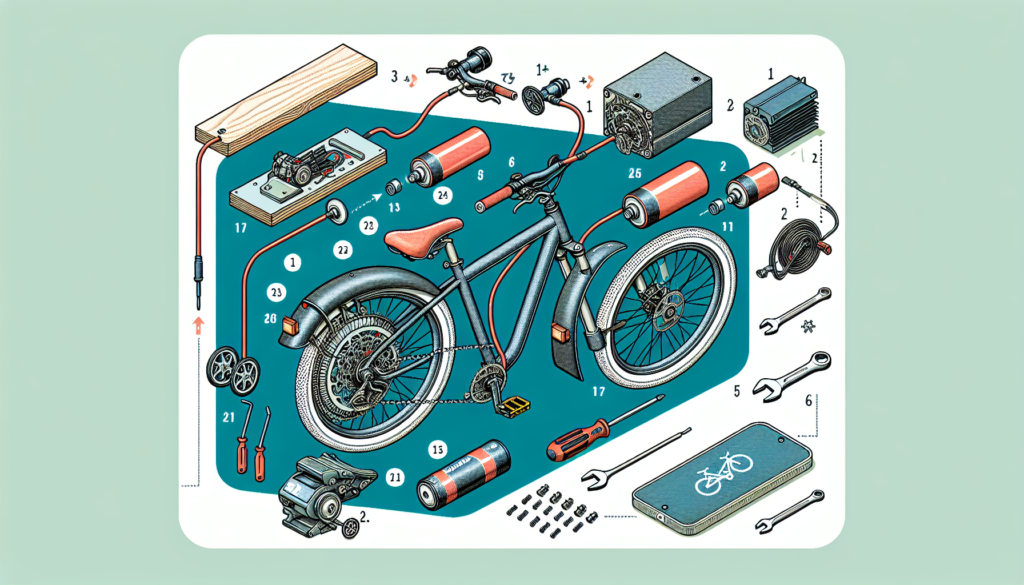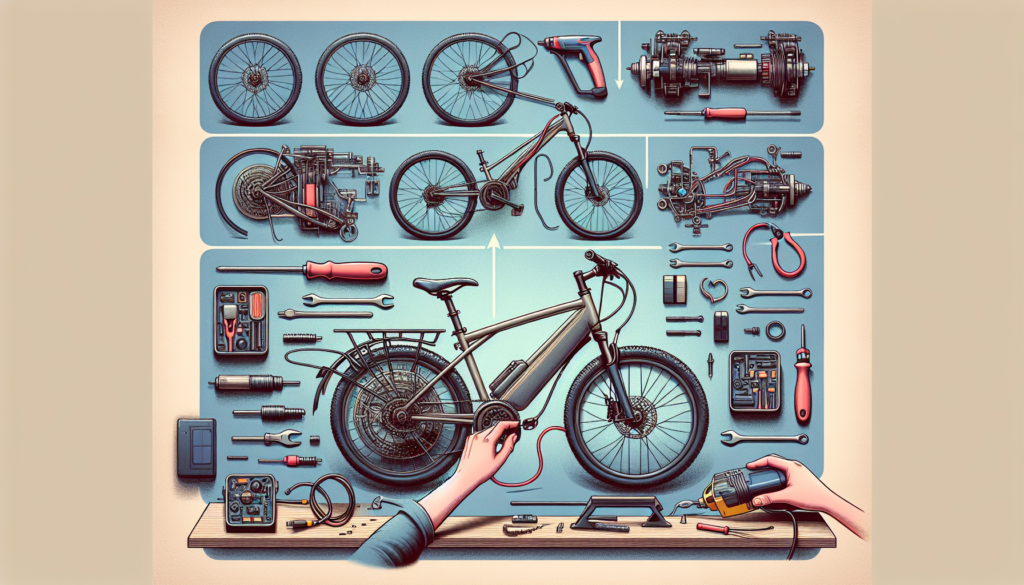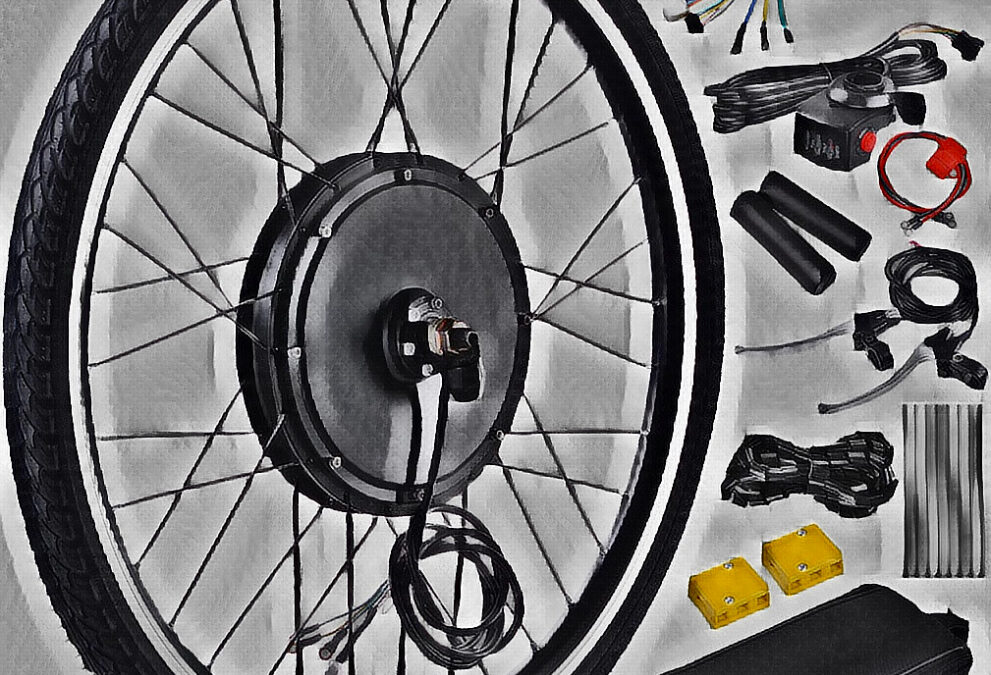Have you ever wondered how to transform your regular bike into an electric one? Look no further! In this article, we will reveal some fantastic tips and tricks on how to make your bike electric. Whether you’re seeking a more sustainable mode of transportation or simply want to add a little extra power to your cycling adventures, we’ve got your back. So grab your tools and get ready to embark on an exciting journey to electrify your bike!
Choosing the Right Conversion Kit
Understanding Your Bike
Before you can begin the process of converting your regular bike into an electric bike, it’s important to have a good understanding of your bike’s individual characteristics. Take note of the frame size, tire size, and overall weight of your bike. Additionally, consider the type of terrain you typically ride on and the distance you usually cover. This information will help you choose the appropriate conversion kit for your specific needs.
Types of Conversion Kits
There are various types of conversion kits available in the market, each offering different features and benefits. The most common types include front wheel, rear wheel, and mid-drive conversion kits. Front wheel conversion kits are the easiest to install and provide excellent balance, while rear wheel conversion kits offer more traction and power. On the other hand, mid-drive conversion kits offer a more natural riding experience as the motor is located near the bike’s cranks. Consider your riding preferences and the level of complexity you are comfortable with when choosing a conversion kit.
Considerations for Choosing a Conversion Kit
When selecting a conversion kit for your bike, there are several important considerations to keep in mind. Firstly, determine the power and range you desire. Conversion kits typically come in a range of power options, so choose one that suits your needs. Additionally, consider the battery capacity and type, as this will impact the range of your electric bike. Finally, think about the level of customization and compatibility with your bike. Some conversion kits may require modifications to your bike frame, so ensure the kit you choose is compatible with your bike’s specifications.
Gathering the Necessary Tools and Materials
Basic Tools
To successfully convert your bike into an electric bike, you will need a variety of basic tools. These include a set of Allen wrenches, a adjustable wrench, a screwdriver set, a chain breaker tool, and a pedal wrench. These tools will help you throughout the installation process and ensure a smooth conversion.
Conversion Kit Components
In addition to the basic tools, you will also need specific components that come with the conversion kit. These typically include a motor, a battery, a controller, a throttle, a display, and wiring harnesses. It is important to carefully check the contents of the conversion kit to ensure you have all the necessary components before beginning the installation process.
Additional Materials
In some cases, you may require additional materials to complete your electric bike conversion. This may include zip ties, electrical tape, heat shrink tubing, and grease. These materials will help you secure and protect the wiring connections and ensure proper functionality of the electric components. It is always better to have these materials on hand before starting the installation process.
Preparing Your Bike for Conversion
Cleaning and Maintenance
Before installing the conversion kit, it is essential to thoroughly clean and inspect your bike. Remove any dirt or debris that may have accumulated on the frame, and check for any signs of damage or wear. Additionally, conduct basic maintenance tasks such as lubricating the chain and ensuring all moving parts are in good working condition. This will not only make the installation process smoother but also prolong the lifespan of your electric bike.
Removing Non-Essential Parts
To make space for the electric components, you may need to remove certain non-essential parts from your bike. This may include fenders, racks, and any accessories that are not required for the conversion. Consult your bike’s manual or seek guidance from a professional if you are unsure about which parts to remove. Remember to keep these parts safe for future use or consider selling them to other bike enthusiasts.
Inspecting and Preparing the Frame
Carefully inspect the bike frame for any signs of damage or stress points. Ensure that the frame is structurally sound and can handle the additional weight of the motor and battery. Additionally, check if there are any specific mounting points or brackets required by your chosen conversion kit. Follow the manufacturer’s instructions carefully and make any necessary modifications to the frame to ensure a proper fit.
Installing the Conversion Kit

Mounting the Motor and Battery
Start by mounting the motor on the designated spot, whether it’s the front wheel, rear wheel, or mid-drive position. Follow the instructions provided by the conversion kit manufacturer to ensure correct installation. Pay attention to the torque specifications for the motor mounting bolts to avoid over-tightening or under-tightening. Once the motor is securely installed, mount the battery on the bike frame in a safe and balanced location. Double-check all connections and fastenings to ensure everything is secure before proceeding.
Connecting the Wiring
Carefully connect the wiring harnesses included in the conversion kit, following the provided instructions. It is crucial to match the corresponding connectors and ensure they are firmly attached. Take your time to route the wiring neatly along the bike frame, using zip ties and electrical tape to secure it in place. Avoid any sharp edges or areas that may cause damage to the wiring. Take extra care when connecting the wiring to the controller, throttle, and display, as incorrect connections can result in system malfunctions.
Securing and Adjusting Components
Once all the wiring is properly connected, secure the various components such as the controller and throttle to the bike frame. Ensure they are firmly attached and positioned in a way that allows for easy access and operation. Take a moment to adjust the position of the throttle and display according to your preference, ensuring they are easily reachable for a comfortable riding experience. Double-check all the connections and fastenings to make sure everything is secure before moving on to the next steps.
Wiring and Electrical Connections

Understanding the Electrical System
To ensure a successful conversion, it is important to have a good understanding of the electrical system of your electric bike. Familiarize yourself with the different components, such as the battery, motor, controller, and wiring. Learn about their specific functions and how they work together to provide power and control to your bike. This knowledge will come in handy when troubleshooting any potential issues in the future.
Proper Wiring Techniques
When it comes to wiring your electric bike, it is crucial to follow proper techniques to ensure safety and functionality. Start by carefully routing the wiring along the frame, avoiding any areas that may rub or create tension. Use zip ties and electrical tape to secure the wiring in place, ensuring they are snug but not overly tight. Avoid any sharp bends or kinks in the wiring that may cause damage or interference. Finally, always double-check your connections to ensure they are tight and secure.
Connecting and Testing the System
Once you have completed the wiring, it is time to connect the battery and test the system. Double-check all connections to ensure they are correct and secure. Turn on the system using the provided switch or button and observe the display for any error messages or abnormal behavior. Test the throttle response and make sure the motor engages smoothly. If everything appears to be functioning correctly, take a short test ride to ensure the system performs as expected.
Battery and Power Management
Battery Selection and Installation
Selecting the right battery for your electric bike is a crucial decision to ensure optimal performance and range. Consider factors such as voltage, capacity, and chemistry when choosing a battery. Lithium-ion batteries are commonly used due to their high energy density and long lifespan. Once you have selected the appropriate battery, carefully install it on your bike according to the manufacturer’s instructions. Take care to secure the battery in a balanced and protected location, using any provided brackets or mounting systems.
Charging and Care
Proper care and charging of your electric bike’s battery are essential for its longevity and performance. Always use the charger provided by the battery manufacturer and follow their instructions for charging. Avoid overcharging the battery and never leave it unattended while charging. Regularly check the battery’s voltage and charge level to ensure it is within the recommended range. Additionally, store the battery in a cool and dry location when not in use to prevent damage or degradation.
Power Management Systems
To optimize your electric bike’s performance and extend its range, consider investing in a power management system. These systems help regulate power flow, monitor battery usage, and provide real-time data on your bike’s performance. Some power management systems even offer features such as regenerative braking, which can help recharge the battery while riding. Research and choose a power management system that best suits your needs and integrates well with your conversion kit.
Testing and Troubleshooting
Initial System Testing
After installing the conversion kit and completing the wiring, it is essential to perform an initial system test. Turn on the bike and check for any abnormal noises, vibrations, or error messages displayed on the screen. Test the throttle response and observe the motor’s performance. Ensure all components are functioning as expected before taking the bike for a proper test ride. This initial testing will help identify any potential issues that need to be addressed before hitting the road.
Troubleshooting Common Issues
Even with proper installation and testing, it is possible to encounter issues with your electric bike. Some common issues include motor stalling, battery not holding a charge, or erratic throttle response. When faced with such issues, refer to the user manual provided with your conversion kit for troubleshooting steps. Additionally, there are numerous online resources and forums where you can seek advice from experienced electric bike enthusiasts. Taking the time to diagnose and address these issues will ensure a smooth and enjoyable riding experience.
Fine-Tuning Performance
Once you have successfully converted your bike into an electric bike, you may want to fine-tune its performance to suit your specific preferences. This can include adjusting the pedal assist levels, tweaking the motor’s power output, or modifying the throttle response. Experiment with these settings and find the combination that provides the most comfortable and efficient riding experience for you. Remember to refer to the manufacturer’s instructions and seek guidance from experienced individuals if needed.
Safety and Legal Considerations
Safety Precautions
While electric bikes offer numerous benefits, it is essential to prioritize safety when riding. Always wear a properly fitting helmet and use appropriate safety gear, such as knee and elbow pads. Familiarize yourself with local traffic laws and regulations regarding electric bikes. Follow all traffic rules, signal your intentions, and be aware of your surroundings. Consider adding lights and reflectors to your electric bike for increased visibility, especially when riding at night.
Applicable Regulations and Laws
Electric bike regulations and laws can vary by country, state, or even city. Before converting your bike into an electric bike, ensure you understand and comply with the applicable regulations in your area. This may include limitations on motor power, maximum speed, or age restrictions. Registering your electric bike with local authorities and obtaining any necessary permits or licenses may also be required. By staying informed and following the regulations, you can enjoy your electric bike safely and legally.
Insurance and Liability
It is important to consider insurance and liability coverage when using an electric bike. While electric bikes are generally considered bicycles, they can still cause accidents or damages. Check with your insurance provider to see if your homeowner’s or renter’s insurance covers electric bikes. If not, consider purchasing additional insurance or liability coverage specific to your electric bike. This extra protection will provide peace of mind and financial security in case of any unforeseen incidents.
Maintenance and Upkeep
Regular Cleaning and Inspection
Like any other bike, electric bikes require regular cleaning and inspection to ensure optimal performance and longevity. After each ride, wipe down the bike frame, motor, and battery to remove any dirt or debris. Inspect the tires for wear and replace them if necessary. Lubricate the chain and moving parts to reduce friction and prevent premature wear. Regular cleaning and inspection will help identify any potential issues and allow for timely maintenance or repairs.
Battery Maintenance
To prolong the lifespan and performance of your electric bike’s battery, it is necessary to follow proper maintenance practices. Keep the battery clean and free from dirt or moisture. Avoid exposing the battery to extreme temperatures, as high heat can reduce its capacity and cold temperatures can decrease its efficiency. Periodically check the battery’s voltage and charge level to ensure it is within the recommended range. Following these best practices will help maximize the lifespan and performance of your battery.
Component Replacement and Upgrade
Over time, certain components of your electric bike may wear out or become outdated. When this happens, it is important to promptly replace or upgrade the affected parts. This can include replacing worn-out tires, upgrading the controller for better performance, or installing a higher capacity battery for extended range. Consult the manufacturer’s recommendations for compatible replacements and upgrades, or seek assistance from a professional bike mechanic if needed. Regularly upgrading and replacing components will ensure your electric bike continues to perform at its best.
Exploring Advanced Electric Bike Modifications
Enhancing Performance and Range
If you find yourself wanting more power or increased range from your electric bike, there are several advanced modifications you can consider. Upgrading to a more powerful motor or a higher capacity battery can significantly enhance your bike’s performance. Additionally, you can explore options such as regenerative braking systems or larger tires for improved efficiency. Remember to consider the compatibility of these modifications with your conversion kit and seek professional guidance if necessary.
Integrating Pedal Assist Systems
Pedal assist systems are a popular addition to electric bikes as they provide a more natural riding experience. These systems detect your pedaling and provide a proportional amount of electric assistance, making pedaling easier and more efficient. If your conversion kit does not include a pedal assist feature, you can explore options for adding a separate pedal assist system. Choose a system that integrates well with your existing conversion kit and consult the manufacturer’s instructions for proper installation and setup.
Customization and Personalization Options
One of the fantastic aspects of converting your bike into an electric bike is the ability to customize and personalize it to your liking. From adding stylish fenders and racks to installing a comfortable saddle or custom grips, there are numerous options to express your style and improve your riding experience. Explore different accessories and enhancements that align with your preferences and make your electric bike unique to you. Just remember to prioritize functionality and safety when selecting and installing these customizations.
As you embark on your journey to make your bike electric, remember to approach the process with patience, care, and attention to detail. By selecting the right conversion kit, gathering the necessary tools and materials, understanding your bike, and following the proper installation techniques, you can successfully convert your bike into an electric one. Always adhere to safety regulations and perform regular maintenance to keep your electric bike in optimal condition. With the right knowledge and preparation, you’ll soon be enjoying the thrilling experience of riding your very own electric bike.


